Laser distance sensors, also known as laser rangefinders, are optical distance measuring devices. They can measure the distance to a given object using a non-invasive laser beam.
Laser distance meters can also work as proximity sensors to detect objects within a certain range.
In this article, we’ll be discussing about laser distance sensors, their working principle and review a few models from some of the most popular manufacturers.
What is a Laser Distance Sensor and How Does it Work?
Laser distance sensor is a device that uses a laser beam to determine the distance to an object. They are also known as laser rangefinders, laser distance meters and laser telemeters.
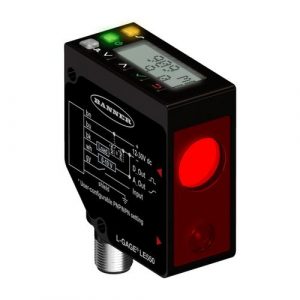
There exist a few ways of measuring the distance such as:
- Time-of-Flight principle
- Triangulation and similar techniques
The time-of-flight principle is the most common form of operation. In this mode of operation, a pulse of laser beam is sent towards the measuring object. This beam is narrowed down using a lens system.
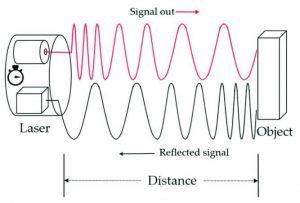
When the beam hits the object, it is reflected off the surface back towards the sensor. The sensor measures the time taken by the beam to travel to the target and return.
In many cases, the sensor itself contains a dedicated signal processor to calculate the timing and determine the distance between the object and the sensor.
Triangulation method uses the angle of the reflected beam to determine the distance of the object. This is also known as displacement technique. These types of sensors use a continuous beam rather than pulses. The reflected beam’s angle changes as shown in the image below:
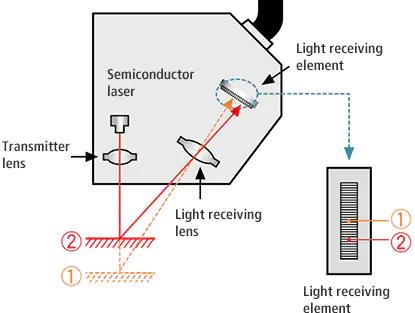
The change in the angle of the reflected beam is proportional to the distance to the object. The light receiving element consists of an array of light sensors which can determine the position of the received beam.
Distance Sensors vs Proximity Sensors
The primary difference between distance and proximity sensors is that the proximity sensors can not directly calculate the distance to an object. Proximity sensors activate their output if they sense an object within their singing range.
This can also be used to determine the marginal distance to the object, but it is not accurate.
Distance sensors calculate the actual distance to the target by using various principles like time-of-flight and triangulation. In a way, distance sensors can also function as proximity sensors, but not vice versa.
Distance sensors also tend to have a much higher sensing range (few centimeters to a few hundred meters) than proximity sensors.
How Accurate are Laser Distance Sensors?
Laser distance sensors have a typical accuracy of +/- 1mm and can measure distances from 0.5 to 150m. The accuracy is denoted as ‘accurate +/- x.xx% percent of the sensor’s span’.
Due to the extremely fast speed of light, laser distance sensors can accurately measure distances from a few millimeters to hundreds or even thousands of meters.
However, this also becomes a disadvantage when measuring sub-millimeter (less than a millimeter) distances as the signal processors may not be fast enough to process the information.
What are Laser Distance Sensors Used for?
Laser distance sensors are used to measure distances to objects without needing a physical contact.They are found in applications like manufacturing, quality control and process monitoring applications.
In the automobile manufacturing industry, laser sensors are used to place components accurately in an assembly. They are also used to measure the tolerances in components to ensure that they are within acceptable range.
In process monitoring applications, laser sensors are used to monitor material level. Laser sensors have no trouble sensing non-transparent and resting liquids and solid material that do not deflect the laser beam.
This is particularly useful in food and chemical industries since it is necessary to use non-contact measurement techniques.
What is the Range of Laser Sensors?
Depending on the type and the emission intensity of the beam, laser sensors can have a range from 50cm to 300m. More powerful laser sensors that can measure distances up to thousands of meters also exist. For example, the ILR-RF250 by Micro-epsilon can measure distances upto 3000m.
Infrared Distance Sensors: Basic knowledge and Working Principle
Infrared distance sensors are also a type of optical distance sensors. The difference between the laser distance sensors and the infrared sensors is that the laser sensor uses time-of-flight method or triangulation method while the infrared sensor uses the intensity of the reflected light.
Similar to other optical sensors, infrared sensors also have a light emitter element (an IR LED) and a receiving element (infrared photodiode) on the sensor.
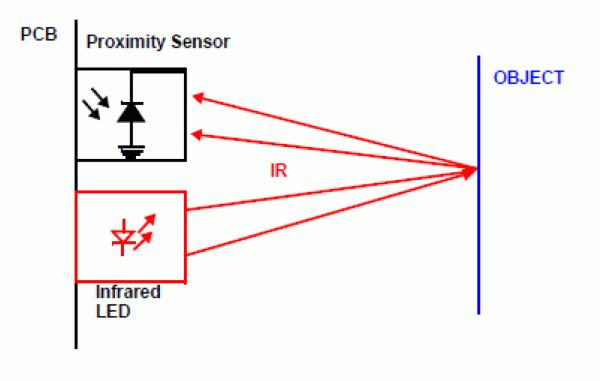
The emitter continuously emits an IR beam towards the object. Depending on the surface of the object, it reflects the IR beam fully or partially.
The IR receiver then measures the intensity of the reflected beam and changes its resistance proportionally. This output of the sensor is this resistance, converted to a voltage/current signal.
IR distance sensors are affected by any infrared sources like lightbulbs or even then sunlight. They also tend to be noisier than laser distance sensors.
However, due to their low implementation cost, IR distance sensors are widely used as proximity sensors and for small, approximate distance measurements where accuracy is not a major concern.
Review on Baumer: Laser Distance Sensors – High Accuracy Distance Sensors
Baumer offers a wide range of optical laser distance measuring sensors which can handle any requirement. Their High performance lineup of distance sensors have a set of high accuracy, close range sensors: the OM70-P/L series laser distance sensors.
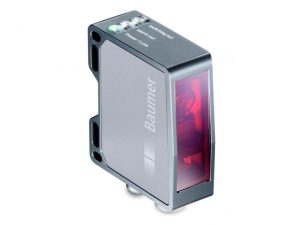
This lineup of high accuracy sensors have a linear error as low as 0.06% and works well in the standards measuring range of 30-70.
Their 0.7-1µm accuracy and 0.8ms response makes them ideal for high precision measurement tasks such as dimensional accuracy checking and tolerance measurements.
The sensors come with standard options like analog and adjustable hysteresis digital push-pull type switching output, wider operating voltage range (15-28VDC) and reverse polarity protection along with ingress protection (IP) rating.
Apart from the digital and analog outputs, some models also support industry standard digital communication protocols like Profinet (Class B), Modbus TCP, OPC UA, UDP streaming over TCP/IP interface.
Review on ifm: Laser Distance Sensors – Short Range
Ifm has 3 families of short range laser sensors: OPD, OGD and O6. OPD and OGD series sensors have 0-300mm range while O6 series have a shorter, 100mm range.
OPD and OGD are the mainstream laser distance sensors and O6 is a diffuse reflection type object detection sensor family with additional distance measurement option.
The OPD series sensors are dedicated profile sensors that can be used in inline assembly quality control. They are easily configurable without additional software using the built-in teach-in mechanism.
They use IO-Link communication interface along with configurable PNP/NPN outputs to provide signal outputs and measurements. OPD series sensors are also immune to extraneous light. They have a range of 150-300mm with an accuracy of 0.5mm
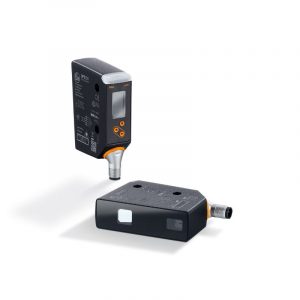
The OGD series use the time-of-flight principle and have a range of 25-300mm with a sampling rate of 33Hz.
This series has an accuracy of 1-2mm and provides distance information through the IO-Link interface. Some models also have a built-in 2-color LCD display that indicates the distance values.
All the families have IO-Link communication interface support and digital/analog outputs. OPD and OGD families have optional LCD display features for easy teach-in and measurement display.
These sensors operate with 10-30V DC and have reverse polarity protection and IP 65/67 rating on selected models.
Review on Micro-Epsilon: Laser Distance Sensors – Long Range
Micro-epsilon has their optoNCDT ILR lineup of sensors with extremely high measuring distances. Their laser gauge type sensors measure up to 10 meters while the laser distance type can measure distances from 0.5m up to 3000m.
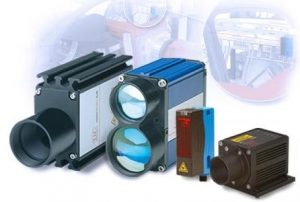
These sensors use the time-of-flight principle and have following key characteristics in the ILR103/118/1191 series sensors:
- 2kHz sampling rate
- 5-3000m measuring range (ILR-RF250)
- Configurable PNP/NPN type outputs
- Adjustable switching points and hysteresis
- RS232, 422 serial interface
- RS485 ProfiBus support
- 10-30VDC operation
- IP67 moisture/dust protection
- Multiple operation types: single, continuous, external triggered, speed measurement
Review keyence: Laser Displacement Sensors
Laser displacement sensors are a more advanced, improved version of laser ranging sensors.
They sense the displacement of an object by using a technique named triangulation. Unlike the single receiver element in time-of-flight sensors, they use a position sensitive device (PSD) to detect the received beam’s deflection.
Keyence has a multitude of laser displacement sensors that suit high speed, high accuracy applications. Their CL-3000 series confocal displacement sensors are ideal for compact applications.
Their signal processing electronics are separated from sensing/emitting elements, which allows easier installation in remote space-constrained locations.
In the ultra high-speed, high accuracy category, Keyence has their LK-G5000 series triangulation displacement sensors with only 0.02% linearity error and 0.005um repeatability. These sensors have a maximum sampling rate of 393kHz for detecting even the smallest vibrations and high-speed targets.
The LT-9000 series sensors provide surface scanning capabilities with a very narrow, 2um beam spot. These sensors are ideal for scanning object surfaces for imperfections and other abnormalities.
They have a built-in camera for capturing images of the surface to identify the measurement location and to provide easy alignment options.
Conclusion
Laser distance sensors are non-contact optical sensors that are used to measure distances with a millimeter-level accuracy. Due to the constant speed of the laser beam, laser ranging sensors produce extremely accurate and repeatable measurements.
An industrial grade laser distance sensor can cost from $30 up to $2000 depending on the features available.